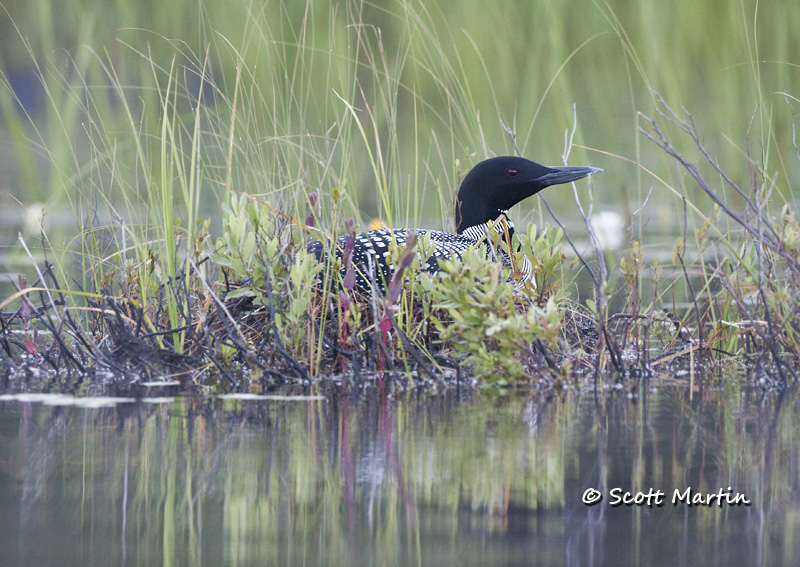
by Scott Martin Photography | Jul 10, 2012 | Birds, Blog, Loons
Over the past few years Deb and I have spent many early weekend mornings in June travelling about sixty kilometres from the cottage to Algonquin Provincial Park and then paddling a couple of kilometres in order to observe and photograph the Common Loon. June is typically the month that Loons are nesting and for the first few days after the chicks are born they spend a lot of time on their parent’s back providing a very desirable photo opportunity.
Loons are an amazing bird God designed to live on the water. They have solid bones and legs that are positioned far back on their bodies allowing them to dive and swim underwater with incredible speed and agility at recorded depths of more than 120 feet. Their design is so tailored to water that they are quite dysfunctional on land where they can only move around by a hopping and pushing themselves on their chest. They are unable to achieve flight from the ground and are only on land while nesting for the 26-31 day incubation period before their eggs hatch. Both parents share in the incubation responsibilities. Loons build their nests on the water’s edge so that they can gain access to it direct fly from the water and the young chicks can easily transition to the water; which they do the day they are born, never to return to the nest. Below is a typical nest located on a small ‘island’ not much bigger than the nest, located about twenty feet from shore and creating an important barrier to protect against predators.

As the Loon chicks move onto the water within hours of their birth, their small size and lack of development requires that they spend much time on a parent’s back for the first week of life. This allows them to rest and keep warm. They also float around on the water, always within a few feet of one of the parents. The parents keep within sight of each other and attend to the young by bringing small fry to them on a seemingly systematic schedule.
They are a pleasure to watch, and the effort required to see Loons up close is always worth it.
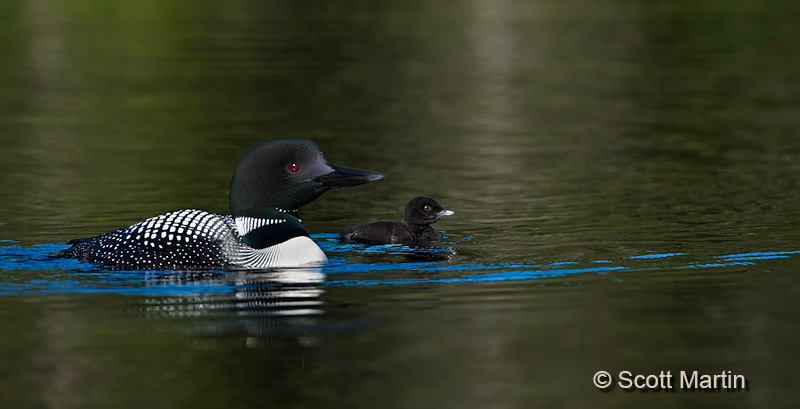
.
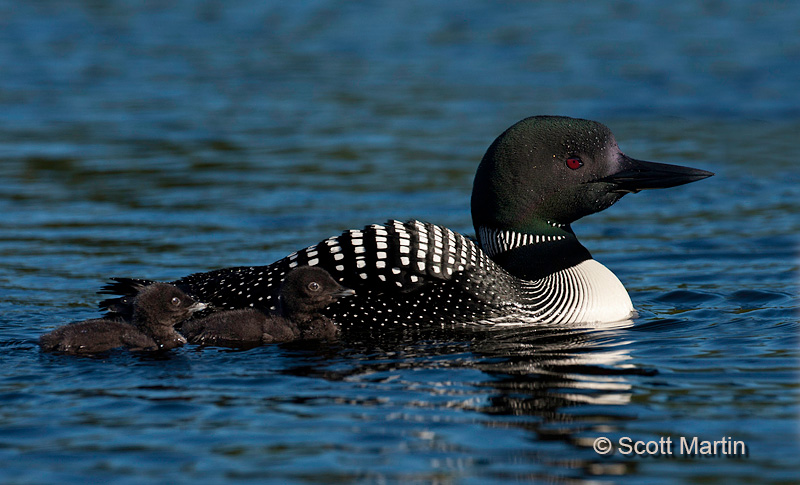
.
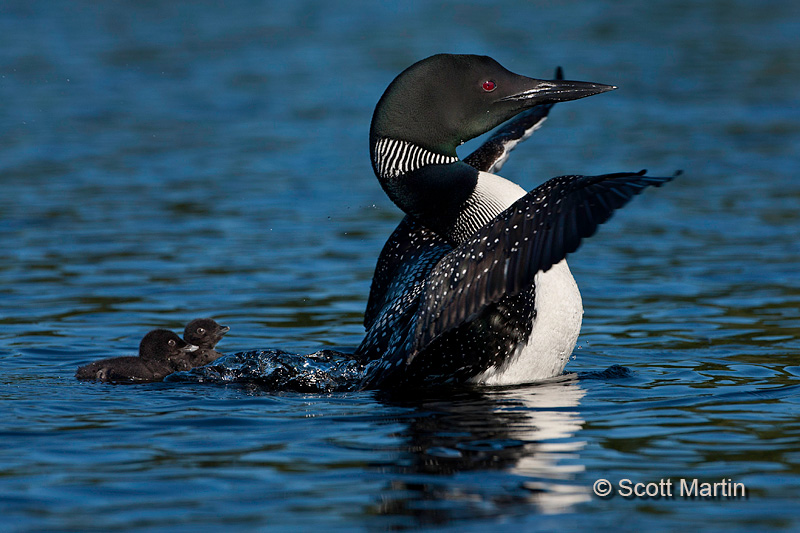
Watching the young chicks get fed is the prefect time to see the special bond between parent and offspring.
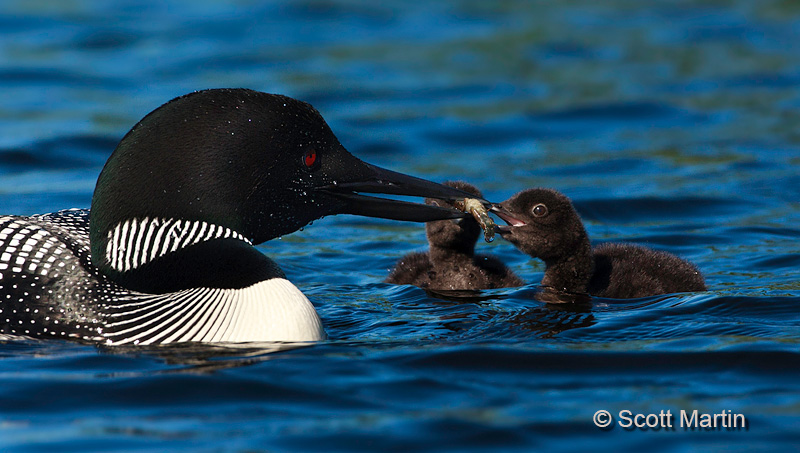
.
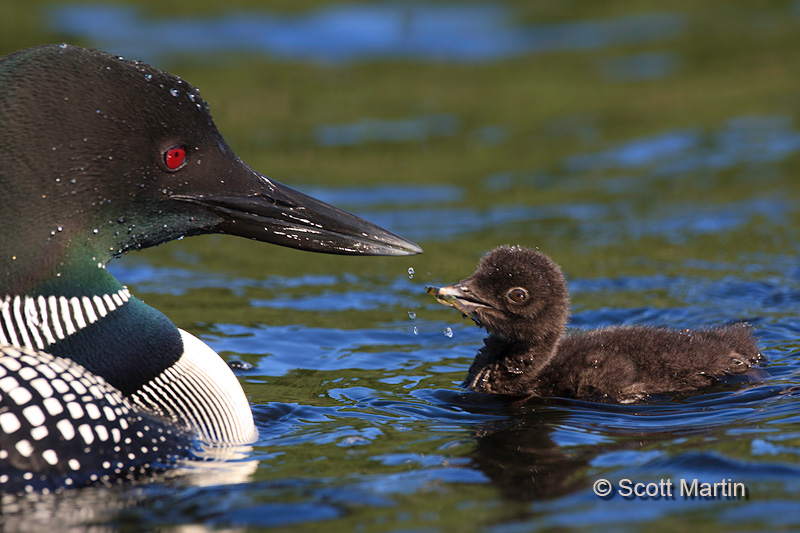
.
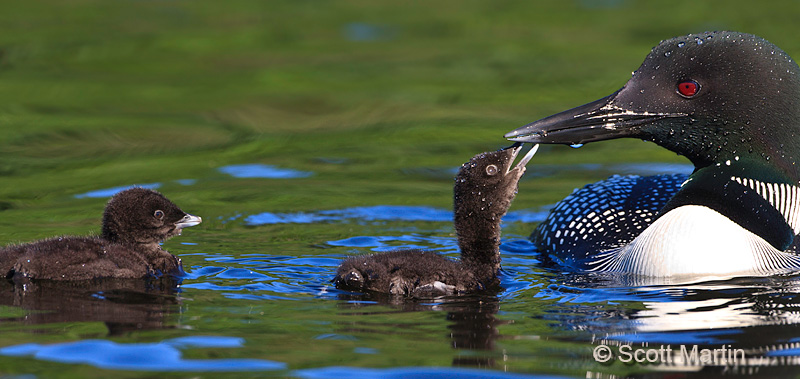
.

.
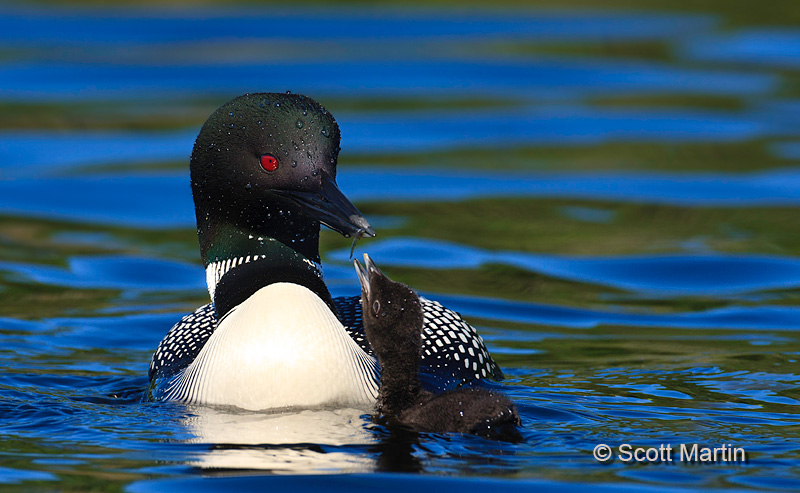
.
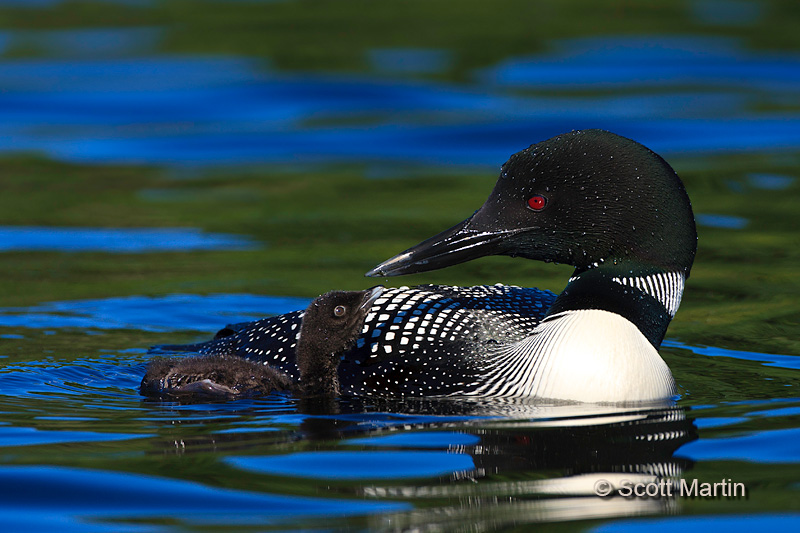
To see the chicks resting on a parent’s back and being sheltered, warmed and protected under a wing was something we’d been hoping to see for the past number of years so the following images are among our all time favourites.
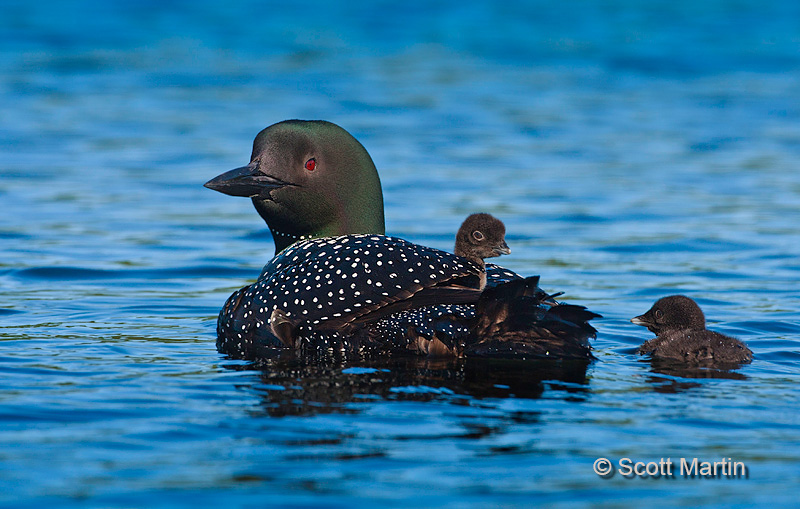
.
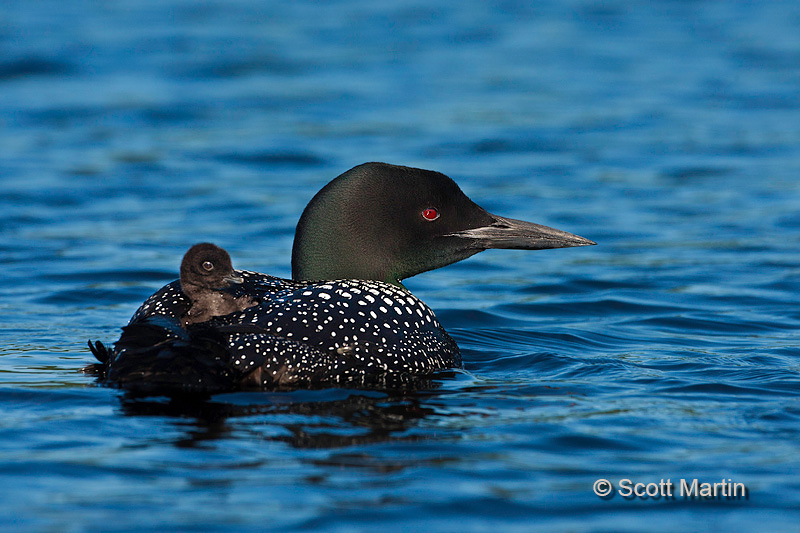
One of the chicks launching off mom’s back.
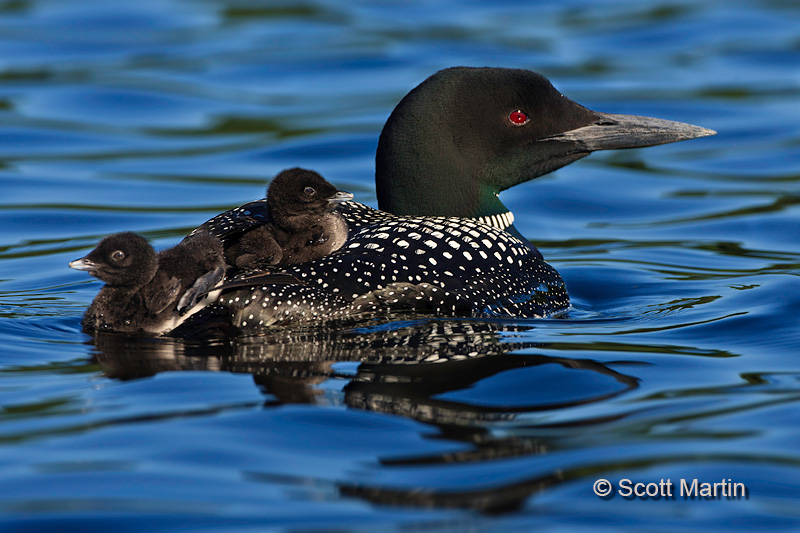
.
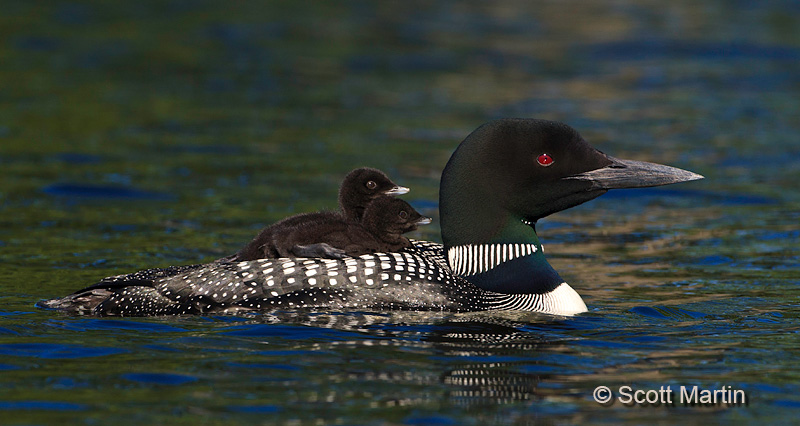
.
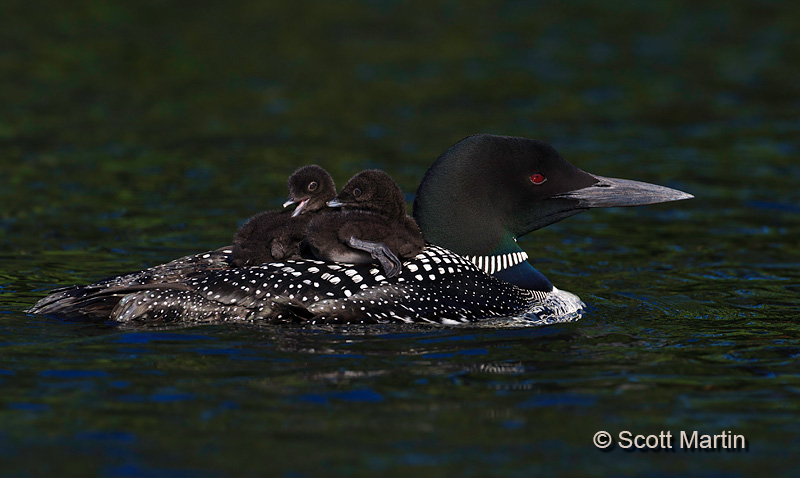
.
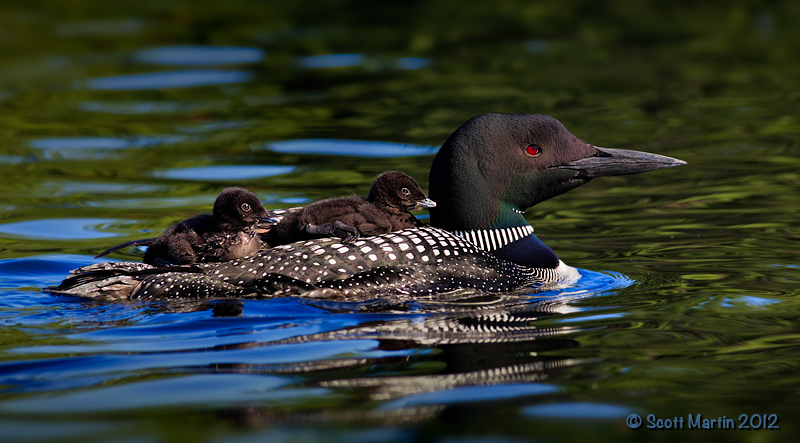
“Hey some day you will be able to do this too”!
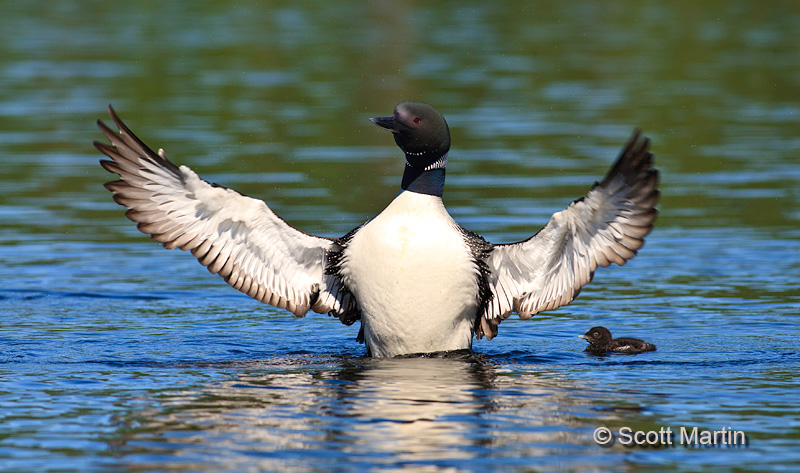
Family shot.
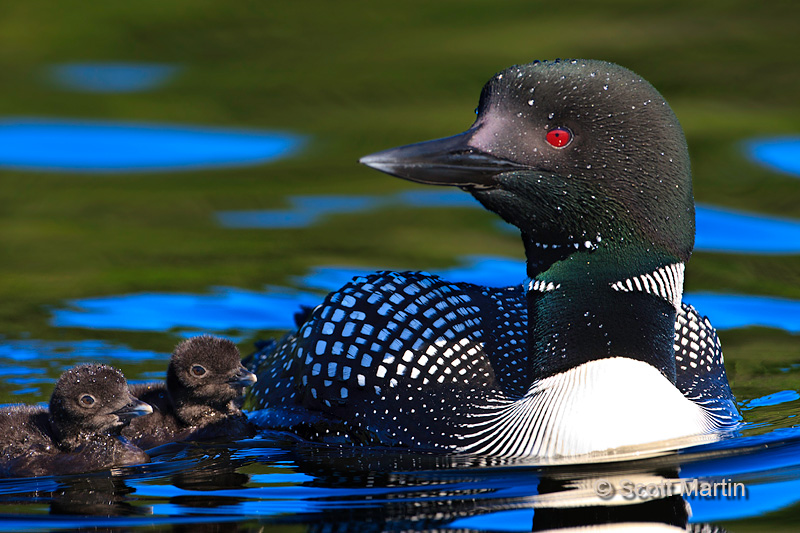
Although it’s a bit precarious taking lots of expensive camera gear in a canoe and quite a challenge to photograph from one, there are not many other ways to get close to Loons. All the images in this post were taken hand-held from a canoe with either a Canon 1D MK III & EF 500mm f4 L IS lens or a Canon 5D MK III and EF 400mm f5.6 L lens. I must thank Deb for single-handedly paddling and positioning the canoe so that the light was always right as we followed these Loons for about three hours. We are a great team but she does all of the work while I snap pictures!
If interested, more images can be seen in the Loons & Grebes Gallery
Please take the time to leave a comment as they are always appreciated and if you have any questions please don’t hesitate to ask.
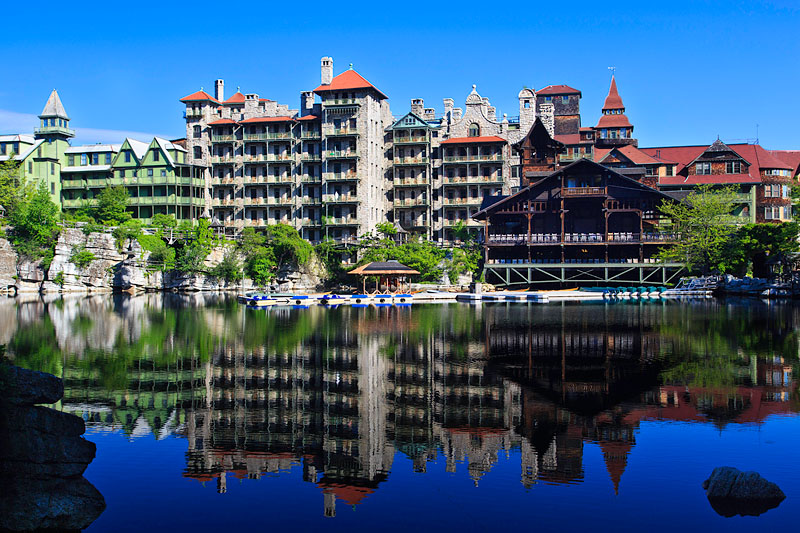
by Scott Martin Photography | Jun 1, 2012 | Blog, Landscapes, Naturescapes, Travel
Deb & I spent a wonderful three days at the Mohonk Mountain House near New Paltz, New York which is about 85 miles due north of New York City. We were there over the Victoria Day Weekend along with about twelve other Chiropractors and their spouses to attend a coaching seminar with TLC 4 Superteams. TLC is one of the premier training organizations for chiropractors and it is a privilege to be one of their coaches; helping other chiropractors provide superb care for their patients.
The Mohonk Mountain House is the #2 Ranked resort spa in the United States and it is well worth the trip if you are looking for a quiet place to get a way for a few days. The 266 room Victorian style lodge was built in 1869 and I believe has remained in the same family since that time. It has entertained presidents, celebrities and normal people like us over the years and offers a multitude of outdoor adventure activities as well as a world class spa to pamper you afterwards.
We didn’t have a lot of time for photography but thought you may enjoy a few snap shots taken around the grounds.
The main lodge taken from across Lake Mohonk

.
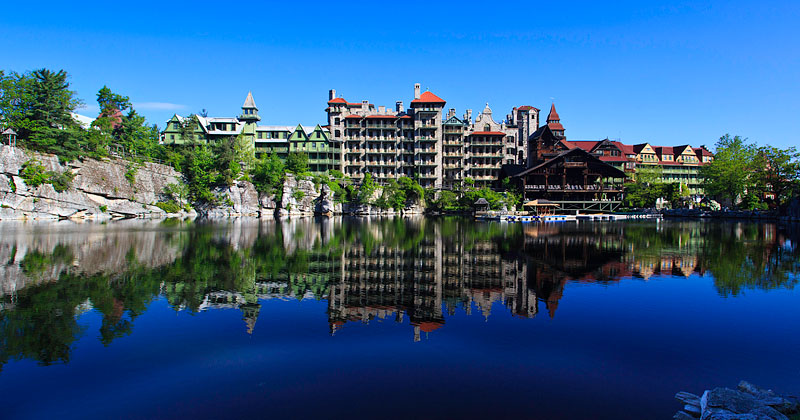
.
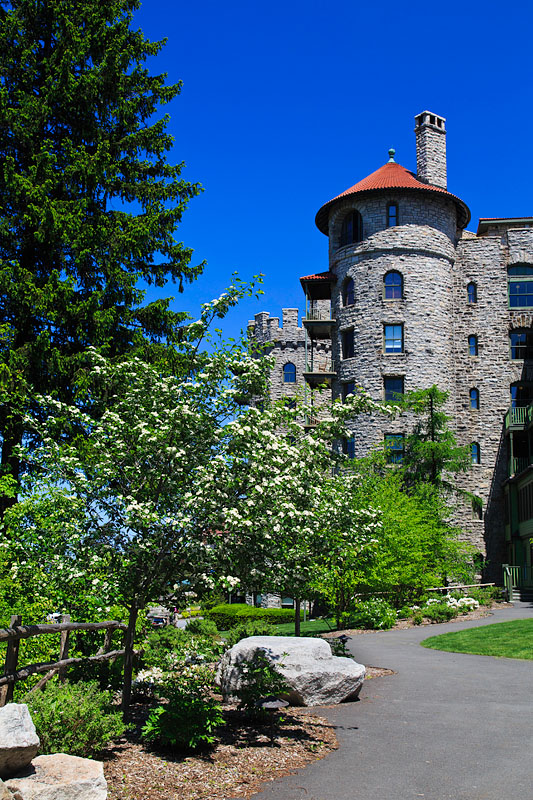
There were many gazebos and porches around the property which were perfect for reading and just relaxing and enjoying the view.
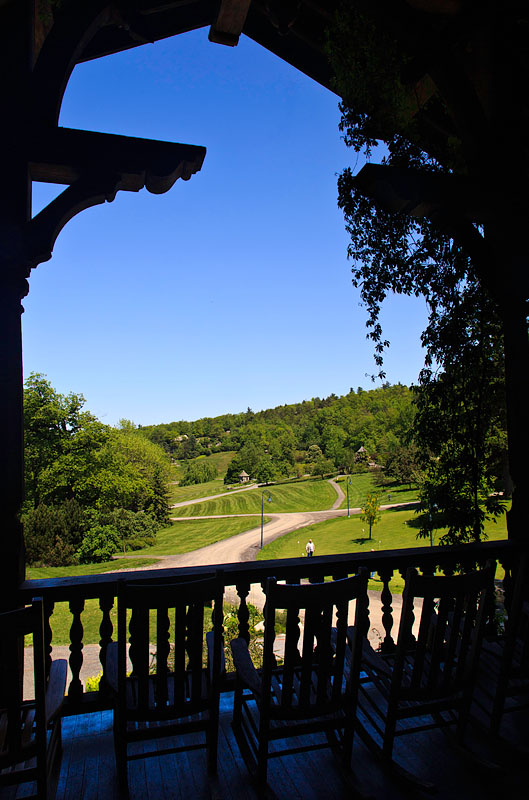
.
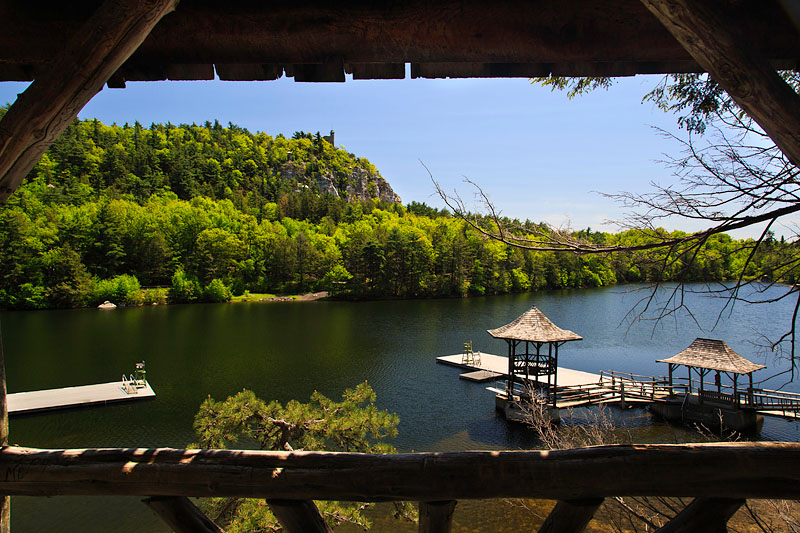
.
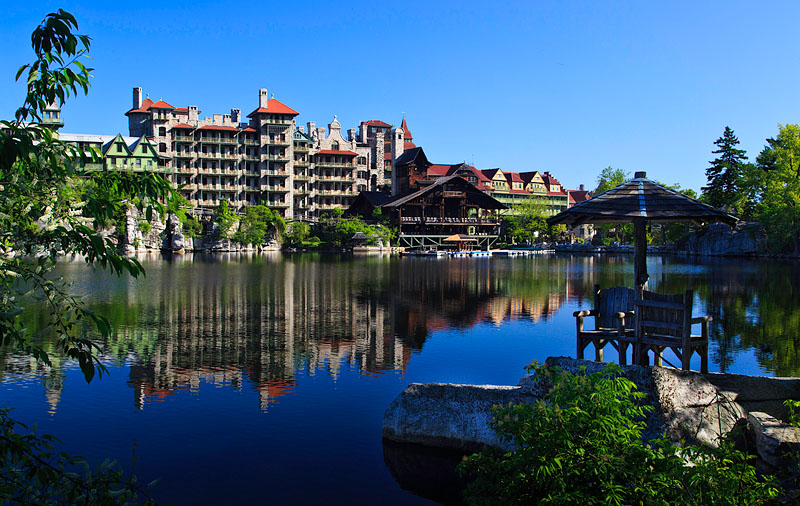
Looking out from the other side of the lodge provided a great view of the Catskills Mountains
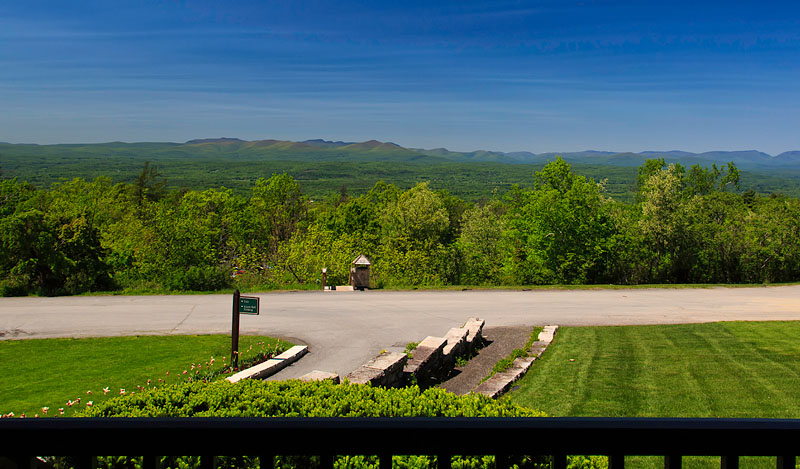
.
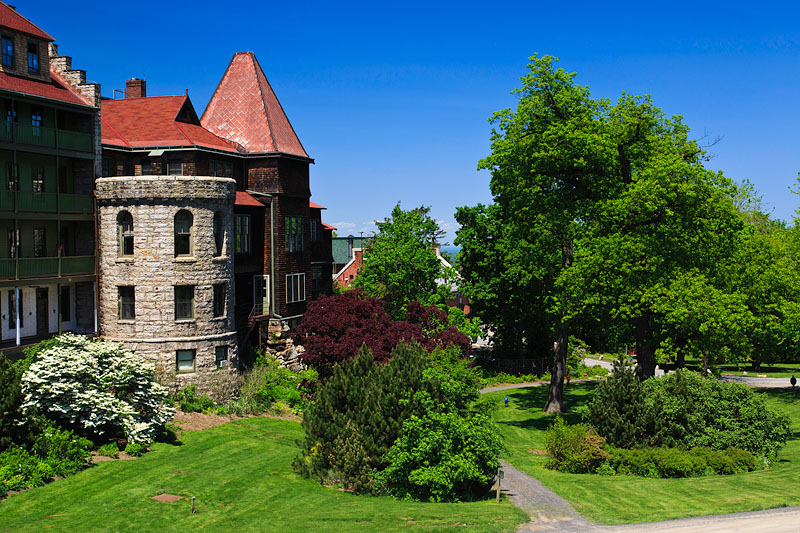
The view from the room.
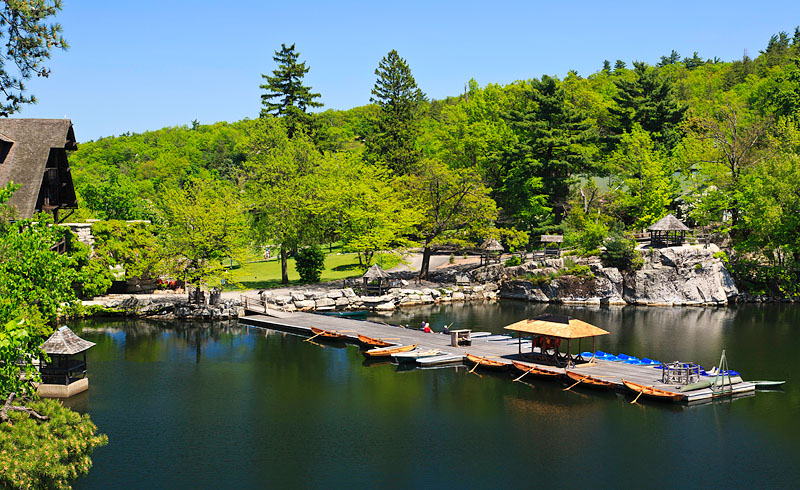
.
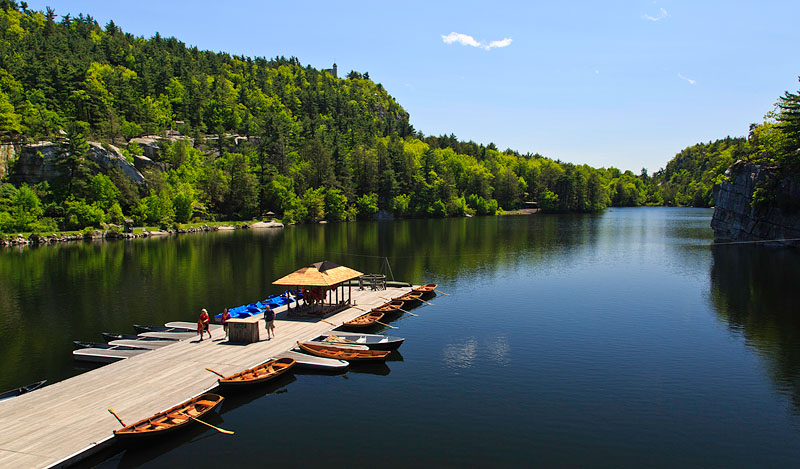
.
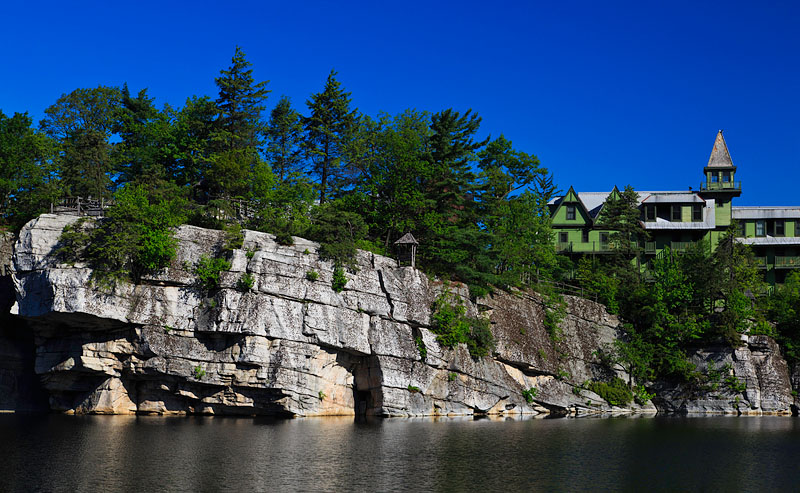
.
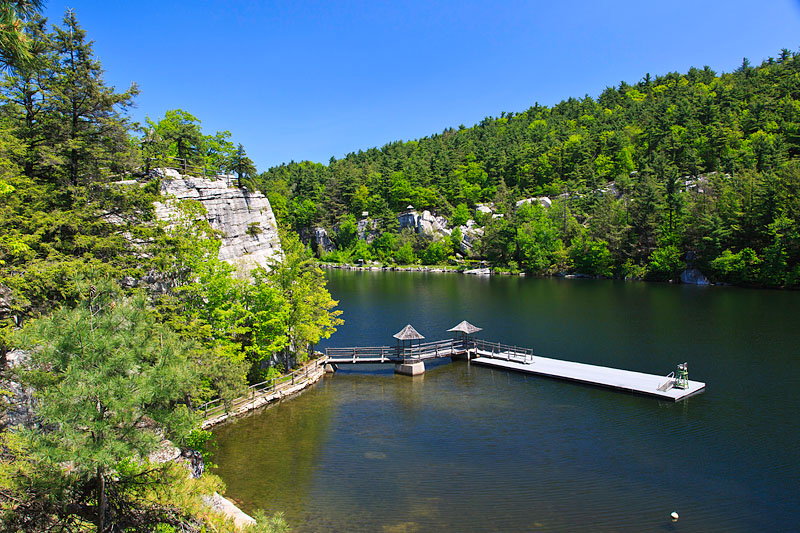
.
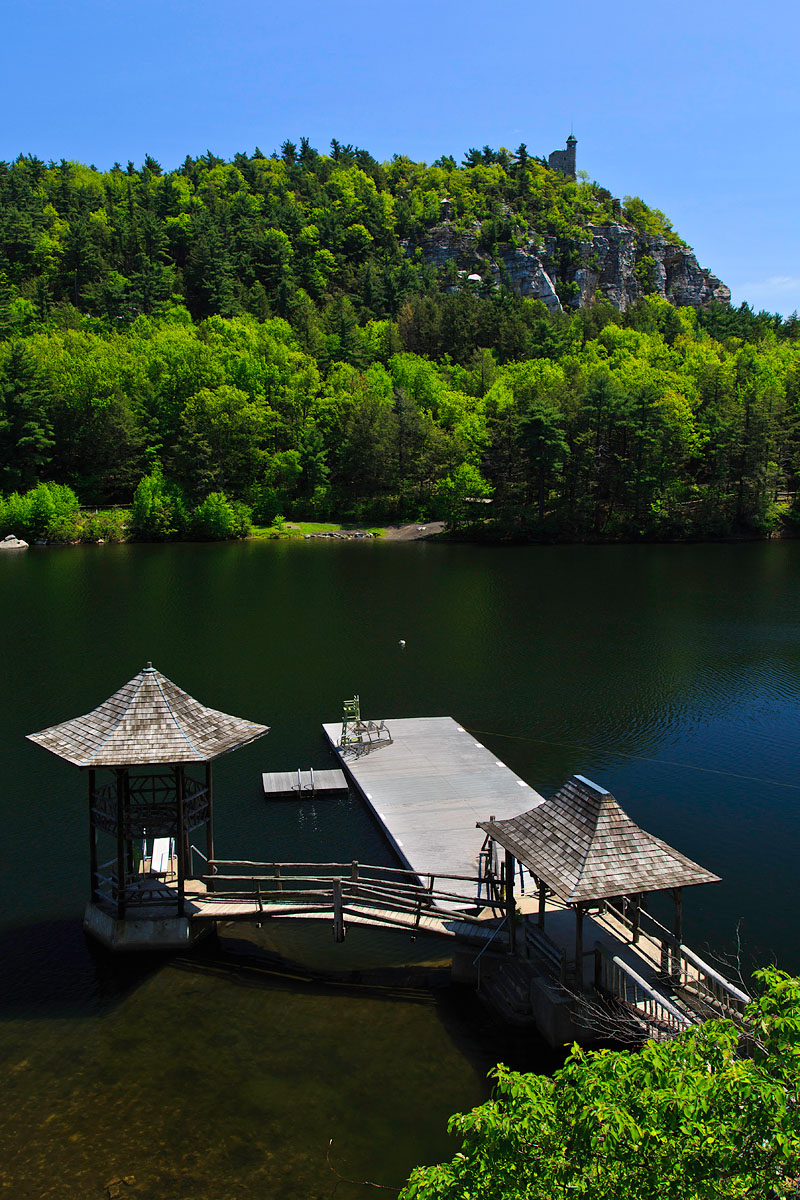
.
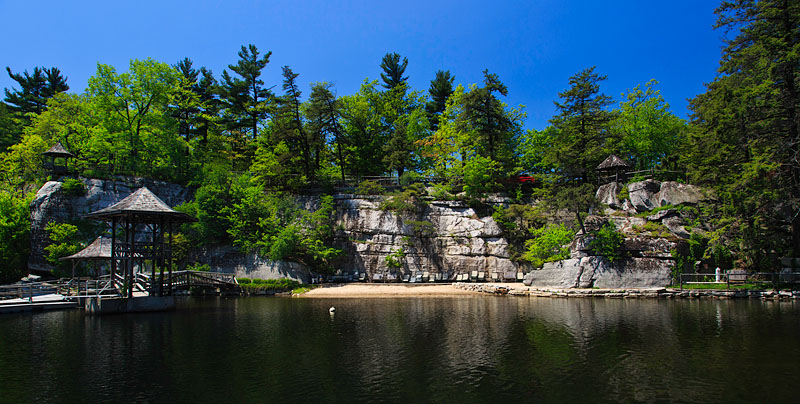
.
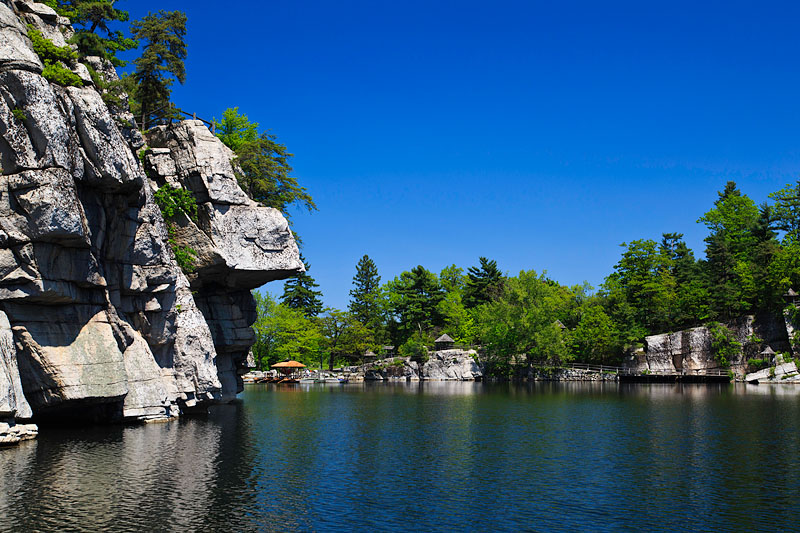
.
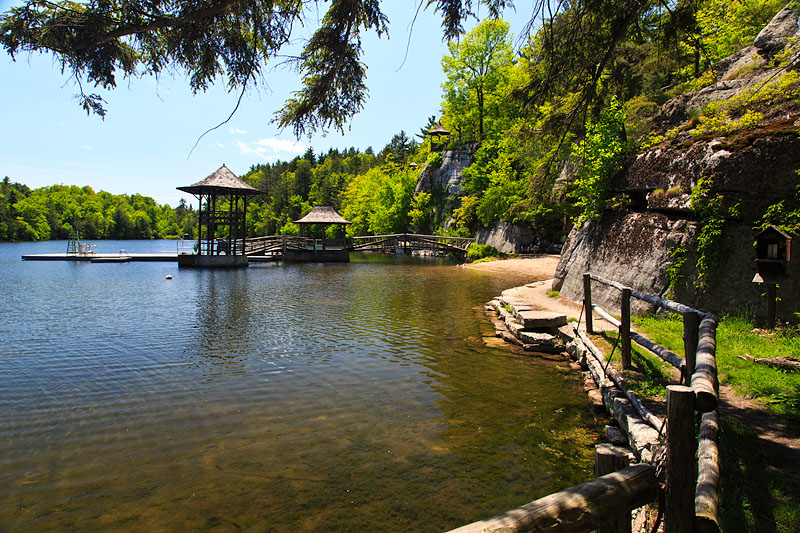
All of these shots were taken with the 5D Mk III and either 16-35 or 24-105 lenses.
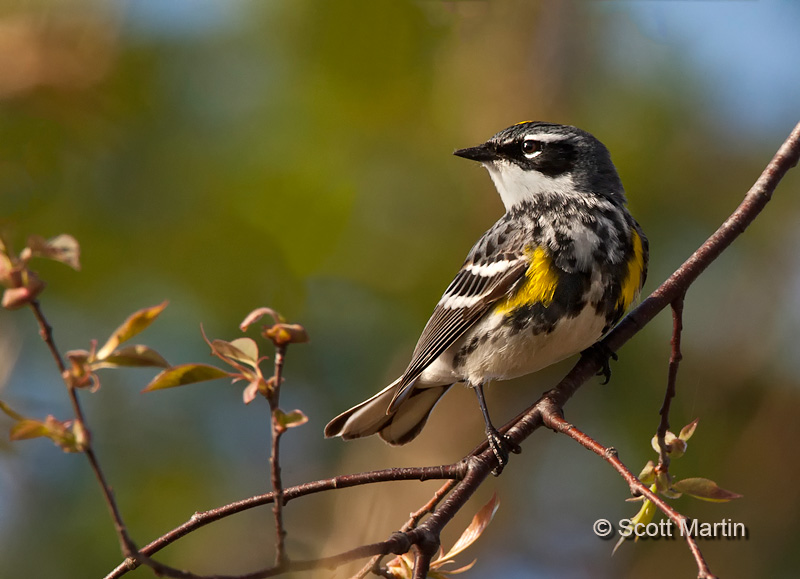
by Scott Martin Photography | May 8, 2012 | Birds, Blog, Educational, Sparrows, Warblers
Although I haven’t had much time to get out with a camera, its great to see the Spring migrants starting to show up in large numbers, especially the Warblers. More than twenty species have been seen in our area and fortunately the leaf cover is still sparse enough that you can catch a good look at most of them. That will all change in the next few days as the leaves and ground cover reach full bloom.
We spent last weekend at the cottage, getting it ready for another summer and it was a pleasant surprise to have a number of Yellow Rumped Warblers in the trees by our deck. Although one of the most common warblers, they certainly are pretty, especially when they pose for you!

This next shot of a Red Winged Blackbird that didn’t want his picture taken is from Cranberry Marsh which is just off Lake Ontario in the south end of the Lynde Shores Conservation area in Ajax, Ontario.
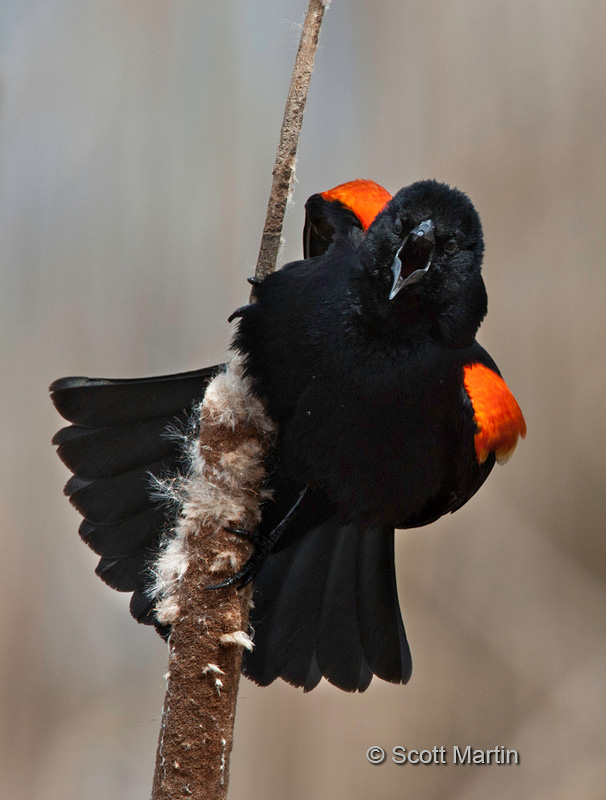
Two photographers whose blog I follow are Darwin Wiggett and Samantha Chrysanthou and one of their recent blog postings talked a lot about using different crops to enhance images, including the square crop. This White Throated Sparrow shot provided a good opportunity to practice with a square crop.
This image was taken in Thickson’s Woods in Oshawa and the Sparrow landed on a very interesting perch, nicely separated from the back ground. The problem is the perch overwhelms the small bird, which is normally a ‘no-no’ for good bird images. Typically you can minimize the large perch by cropping the photo to minimize the visual impact of the perch, resulting in this typical landscape oriented crop.

After reading Darwin’s blog on square crops, and quite liking this large perch, I decided to re-do the little sparrow on the big perch in a square format.
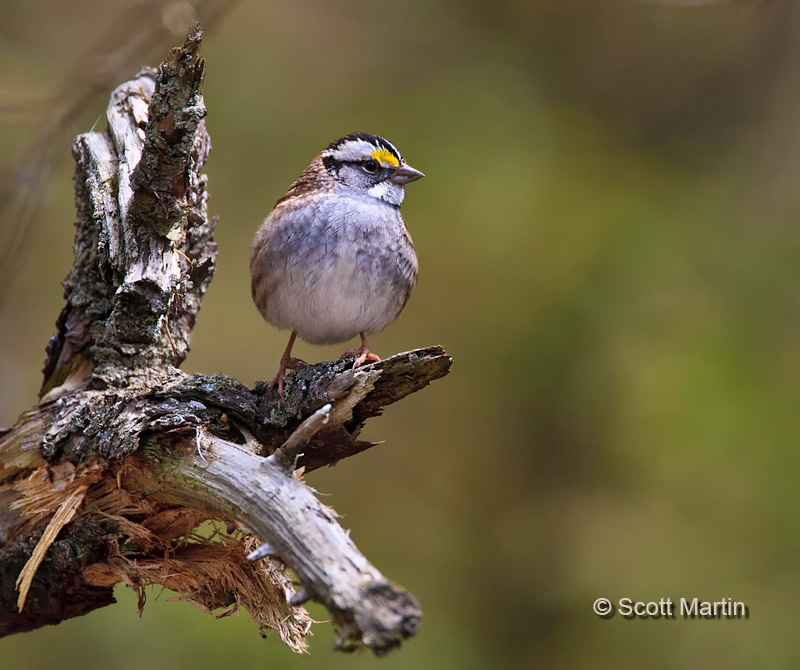
It is always a good practice to think outside the box and break down some of the traditions we photographers cling to, especially when it comes to composition and all the other ‘un-written’ rules of photography.
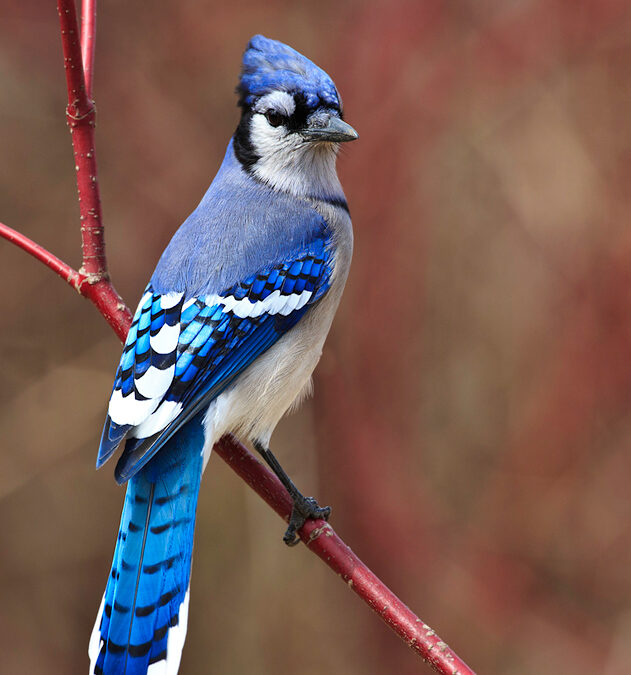
by Scott Martin Photography | Apr 27, 2012 | Birds, Blog, Educational, Sparrows, Woodpeckers
Canon is clearly the global leader in DSLR sales, with $10.5B in sales in 2010 compared to second place Nikon with $2.5B in sales. Sony places a distant third in the pecking order. A number of months ago Canon announced the release of two new camera bodies, the 1Dx and the 5D Mk III, Both of these bodies have full frame sensors, meaning that the size of the electronic sensor is the same as the frame size of the old 35mm SLR film cameras (36x24mm). The vast majority of DSLR’s sold today have smaller sensors, which results in the sensor ‘seeing’ a smaller field of view than would be seen with a 35mm film camera having a lens of equal focal length. The quantification of this phenomenon, called the Crop Factor, is made by determining the ratio between the diagonal length of the reference sensor size and the diagonal length of the smaller sensor. With crop body DSLR’s the crop factor is typically 1.3 or 1.6 for Canon cameras and 1.5 for Nikon cameras. The crop factor allows the photographer to calculate the effective focal length of a lens on a crop body camera compared to that same lens on a full frame camera. For example if a 50mm lens is attached to a DSLR with a 1.5 Crop Factor, the 50mm lens will perform as a 50 x 1.5 or 75mm lens would on a film body.
You may be saying to yourself “Who cares”, however it does make a difference based on the type of photography you do. For example landscape photographers often want to capture as large a field of view as possible and therefore use wide-angle lenses (shorter focal length lenses) to accomplish this. Right away it becomes evident that crop body cameras are a detriment if the widest possible field of view is desired. A 16mm lens effectively becomes a 25.6mm lens on a 1.6 crop body. This is why nature photographers prefer full frame DSLR’s for landscape work. The bird photographer on the other hand finds that the crop body is a great help to getting better shots because of the advantage gained by the crop factor. My 700mm lens effectively becomes an 1120mm lens on a 1.6 crop body.
The problem with photography becomes what to do when buying a camera if you are both a landscape and a bird photographer. There is an easy answer to this question…..buy two cameras, a crop body and a full frame body! Besides, if you are a serious photographer, you really should have some redundancy in you gear. If your only body broke while shooting a wedding it would be a disaster, so a second body is always a good idea.
Anyway, in order to heed my own advice, a Canon 5D Mk III was added to the gear bag a couple of weeks ago and so far its been a pleasure to use and fun to be playing with the first full frame camera since selling my old EOS 630 back in the early nineties. The new 5D Mk III has a 22.4 megapixel sensor and Canon’s new 61 point auto focussing system which is surprisingly fast. It’s ISO range of 50-102,400 is amazing and means this camera almost sees in the dark! Another new perk for me is that the 5D also shoots full HD video which is going to be fun.
The following images are among the first taken with the camera and have not been processed other than converting and resizing the RAW files for display on the web.
Blue Jay
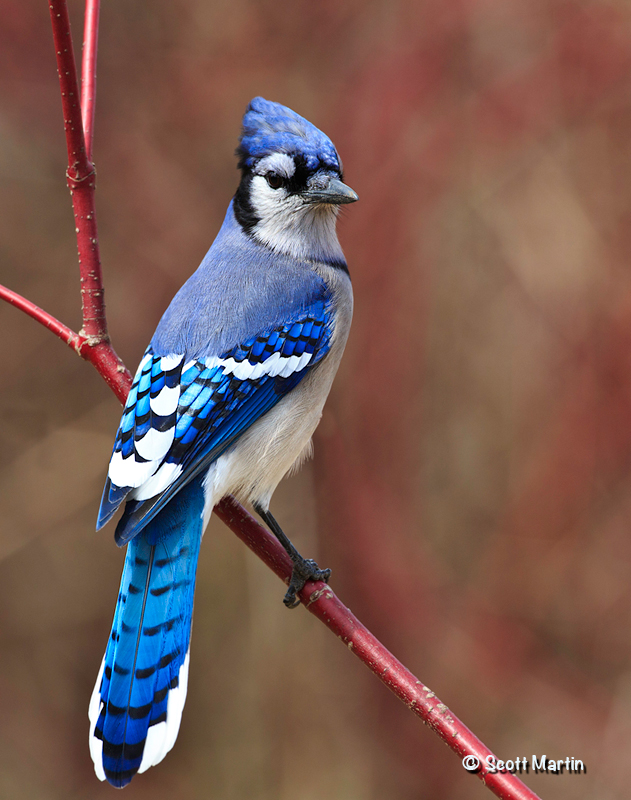
Downy Woodpecker
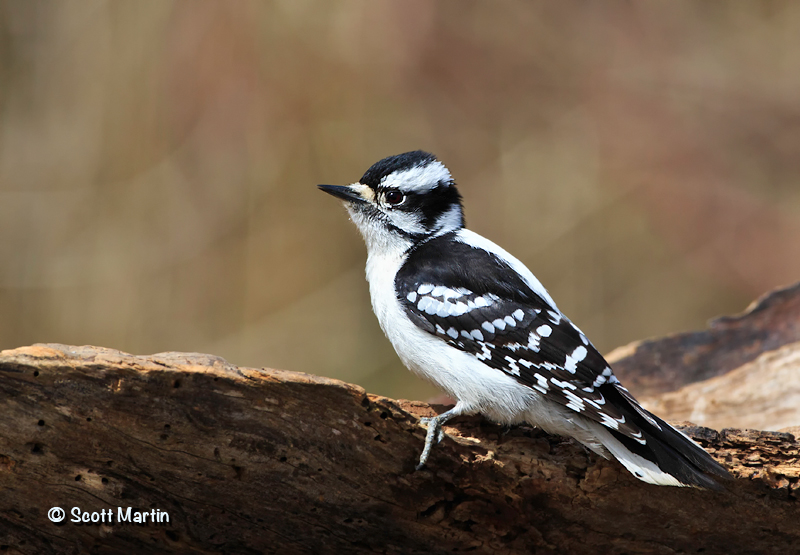
Junco
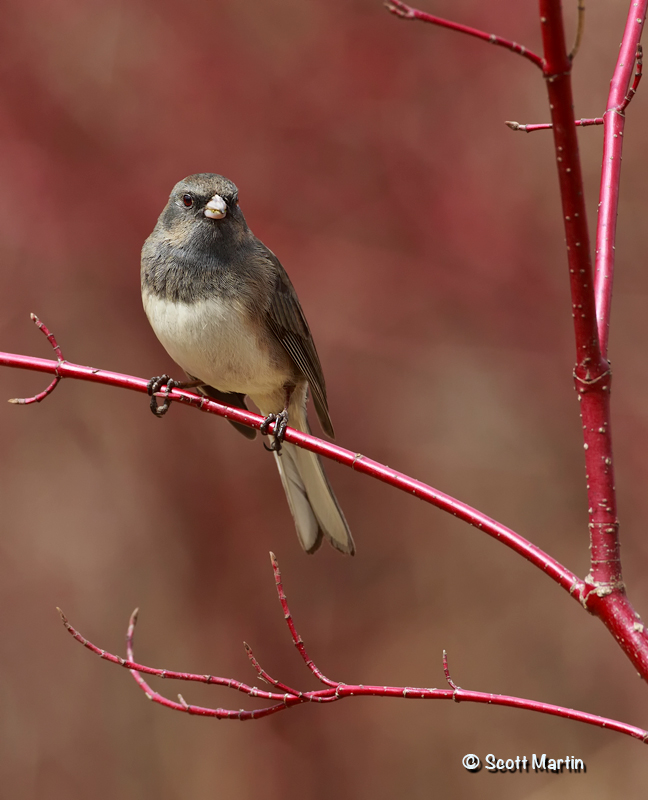
.
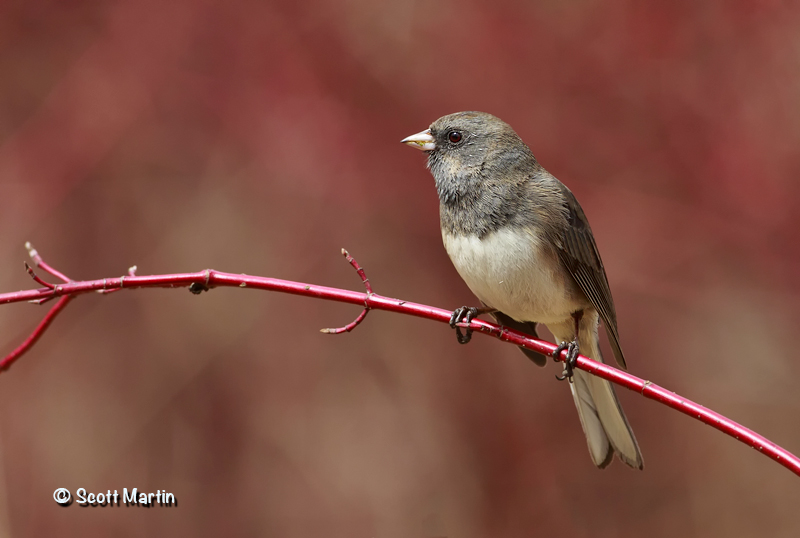
Red Winged Blackbird
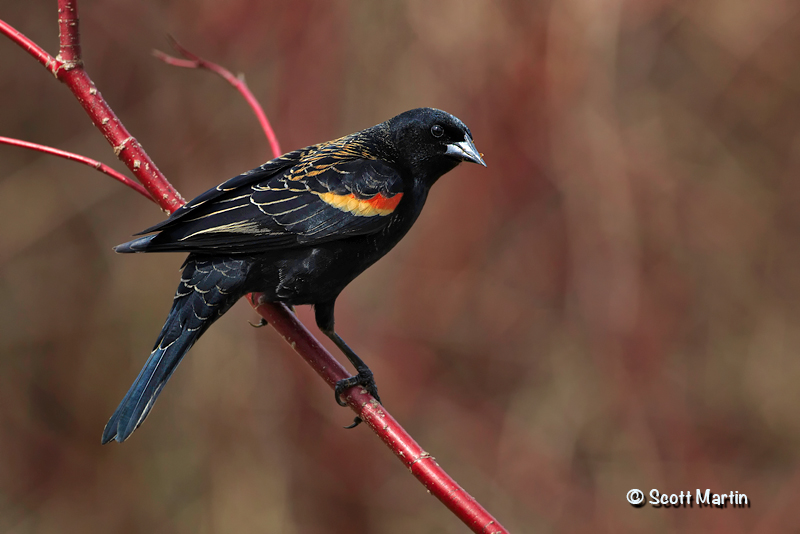
Red Squirrel
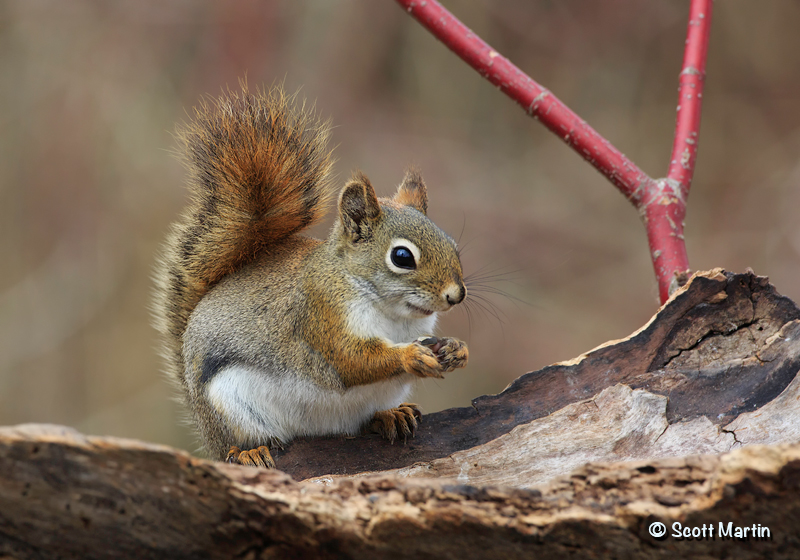
And finally a link to a quick video test of a Red Squirrel
As time permits I plan to post a few more detailed tests of the camera, especially ISO comparisons to help determine how high the ISO can be pushed and still get a useable image.
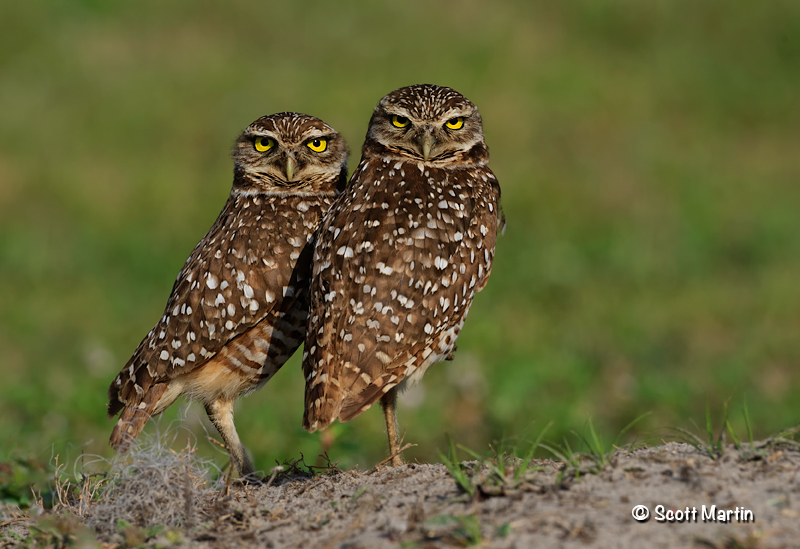
by Scott Martin Photography | Apr 13, 2012 | Birds, Blog, Raptors, Travel
This past year it has been a bit of a challenge to photograph owls and this has led much travel however each mile has been a pleasure, especially in the case of the Burrowing Owl who wisely chooses to live in Florida! Last month we went with our son and daughter in law to photograph Burrowing Owls in Hollywood, Florida which is a suburb of Fort Lauderdale. We visited about six burrows and saw about half a dozen different birds.
Burrowing Owls are small birds approximately 9″ tall with a wing span of about 24″ and have characteristically long legs giving them a unique appearance. They are a relatively common owl found throughout North and South America however as they tend to favour the western parts of the Americas we don’t see them in Ontario. As their name indicates, these small owls live underground, a rarity for animals that fly! Non-migratory Burrowing Owls will occupy the same burrow for many years and spend most of their time very close to the burrow, taking flight to catch bugs and insects or avoid being preyed upon by snakes or even cats. There is not much dimorphism between the sexes however the males tend to be slightly longer and leaner and often lighter in colour which is thought to be due the bleaching effect of the sun on the males who are typically outside of the burrow more than the female.
A good-looking couple!

.
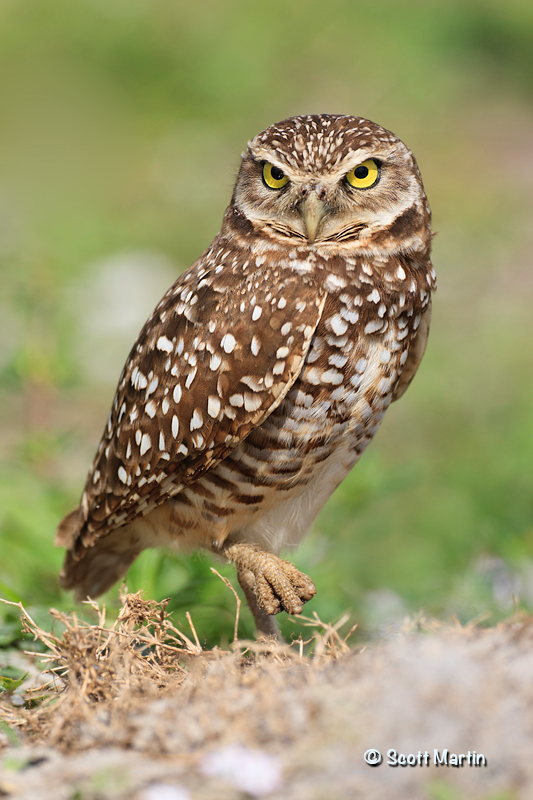
.
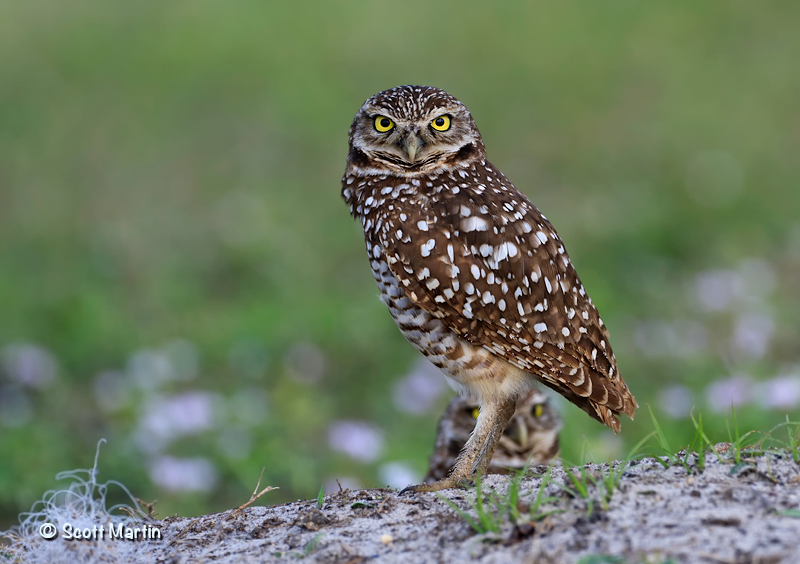
.
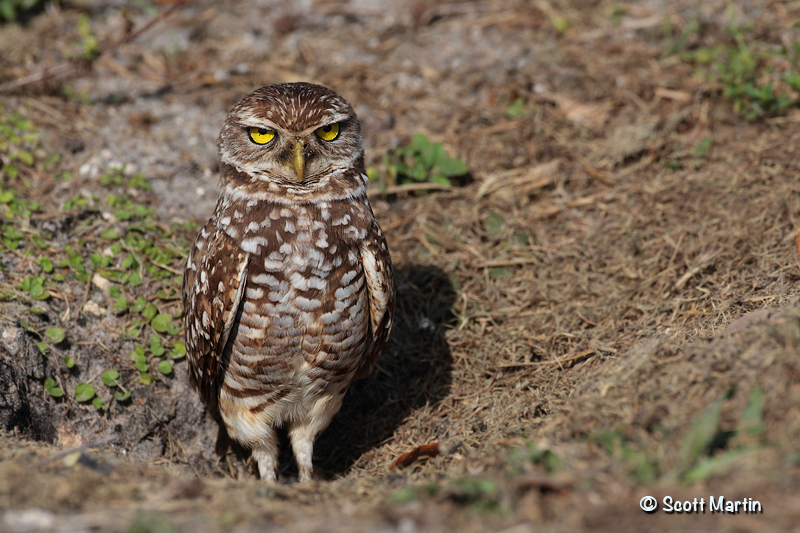
.
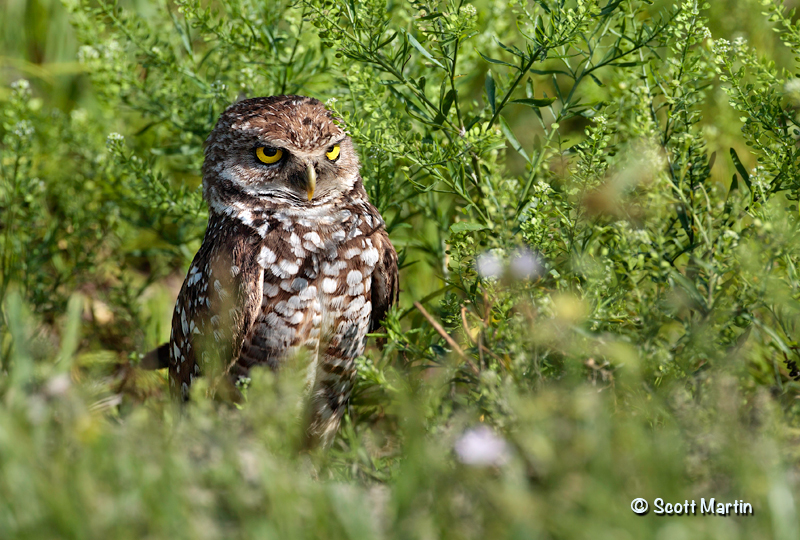
.
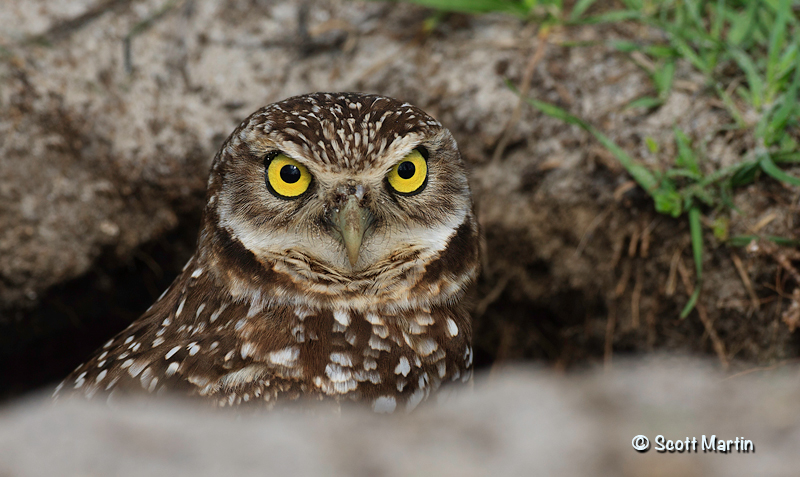
Just to show that Burrowing Owls really do burrow their own homes, even if it means throwing sand on their partner!
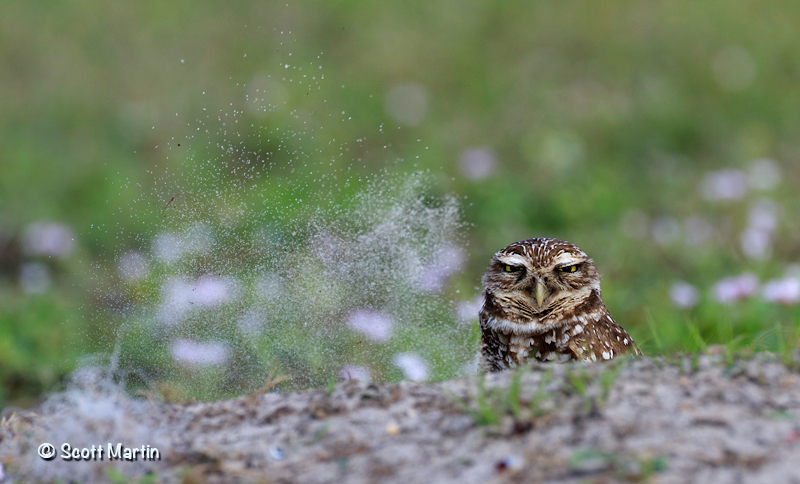
But don’t worry he felt bad and immediately and meticulously removed all the sand 🙂
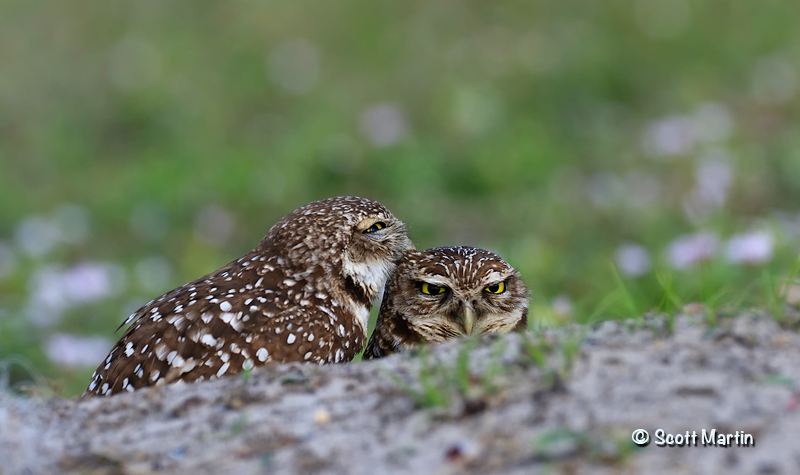
The Burrowing Owl is constantly scanning the environment for threats and responds immediately when one is detected. When I looked around after seeing this expression there was one hawk flying overhead, at least three hundred yards away. Owls are unique in that each of their pupils respond independently to incident light and you can see the different pupil sizes in the following image.
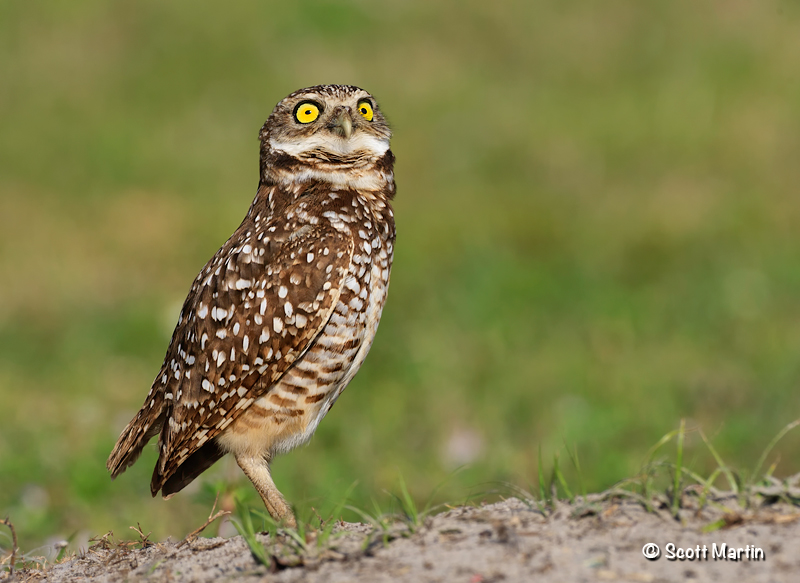
We had an enjoyable time watching the Burrowing Owls as they are quite active through the day although they do most of their hunting between dusk and dawn. The next time you are visiting the sunshine state, you might just want to go looking for a burrow; you will be glad you did!



























































Follow Scott Martin Photography